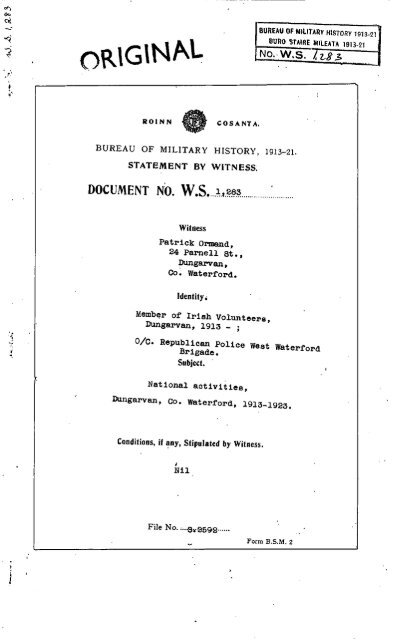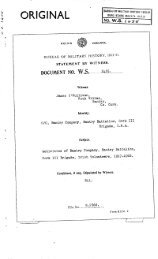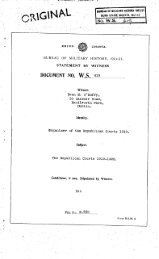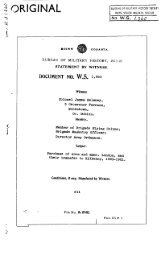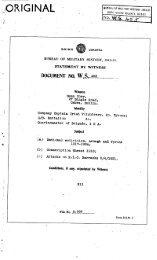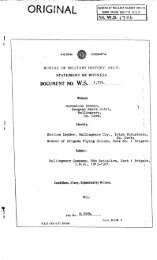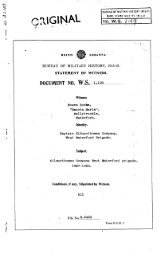ROINN COSANTA. BUREAU OF MILITARY HISTORY, 1913-21 ...
ROINN COSANTA. BUREAU OF MILITARY HISTORY, 1913-21 ...
ROINN COSANTA. BUREAU OF MILITARY HISTORY, 1913-21 ...
Create successful ePaper yourself
Turn your PDF publications into a flip-book with our unique Google optimized e-Paper software.
<strong>ROINN</strong><strong>COSANTA</strong>.<strong>BUREAU</strong> <strong>OF</strong> <strong>MILITARY</strong> <strong>HISTORY</strong>, <strong>1913</strong>-<strong>21</strong>.STATEMENT BY WITNESS.DOCUMENT NO. W.S. 1,283WitnessPatrick Ormand,24 Parnell st.,Co.Waterford.Identity.Member of Irish<strong>1913</strong>0/C. Republican Police West WaterfordBrigade.Subject.Dungarvan,NationalCo.activities,Waterford, <strong>1913</strong>-1923.Conditions, if any, Stipulatedby Witness.INilFile No. S.2592Form B.S.M.2
STATEMENT BY PATRICK ORMONDE,24 Parnell Street, Dungarvan, Co. Waterford.I was born in the year 1897, about one and a halfmiles from the town of Dungarvan, Co. Waterford. Myparents, who were native speakers of Irish, were smallfarmers. From an early age, I too was a fluent Irishspeaker, as I am to this day.I joined the National Volunteers on their formationin Dungarvan in the year <strong>1913</strong>. At the time, I wasserving my apprenticeship to the drapery trade in thetown. I remember Eoin MacNeill and The O'Rahillyaddressing a meeting in the town hall, Dungarvan, atwhich they asked the men present to join the Volunteermovement. Following this meeting, about five hundredmen in the Dungarvan district enrolled as Volunteers.We drilled in Dan Fraher's field, known as theGaelic Fields", a short distance from the town. Ourdrill instructors were men who had served in the Britisharmy. We carried wooden guns when drilling and onparades.When the split in the Volunteers came in 1915,I, together with about eight or ten others, left theNational Volunteers and formed a small Irish Volunteerunit. Pax Whelan of Dungarvan was regarded as theleader of this unit. Amongst others whose names I canremember were George Lennon, Dungarvan, afterwards 0/Cof the West Waterford Active Service Unit, Jimmy Fraher,Peter Cullinane, Thomas Parsons, Michael Morrissey
-2-(afterwards T.D. for Co. Waterford), Patrick Croke,Pakeen Whelan, Joseph Vyse and Phil O'Donnell, all ofDungarvan.In the year before the Rising of 1916, our smallunit met for occasional drills and talks, but, so far asI am aware, we had no guns at all. There may have beena .22 rifle or a shotgun or two in the party, but I,certainly, had no gun. The Company, if such it couldbe called because of the few members in it, was of novalue as a fighting force when the, Rising of Easter 1916did break out. I doubt if we had any contact at allwith Dublin at the time. Pax Whelan, our leader, mayhave been in touch with the Volunteer Executive inDublin, but I don't think he was, because the first newsof the Insurrection in Dublin which reached me came froman assistant in Kiely's drapery shop, where I worked, whohad heard of the fighting in Dublin.No action was taken by our Volunteer unit duringEaster Week, 1916. The only item of note which I canremember was the arrest of two Dungarvan men, Dan Fraherand Phil Walsh. These men were attending a G.A.A.Congress in Dublin which took place on Easter Sunday ofthat year, and, on their arrival in Waterford city bytrain from Dublin after the Rising, they were arrested bypolice and subsequently interned in Frongoch, Wales.The Irish Volunteers were reorganised in thisdistrict in January, 1917. There were about a dozenof us in the Dungarvan CompanyBattalion, West Waterford Brigade- known as A., 1st- for a start, our0/C being Pax Whelan.
-3-So far as I can recollect, we had very littlearms at that time. There was, I remember, a .22rifle with which we practised occasionally, andpossibly Pax or George Lennon, the Vice 0/C, had arevolver or two. There may, also, have been a coupleof shotguns in the Company.We drilled in a field outside the town ofDungarvan and received lectures on field manoeuvresand signalling. I was, subsequently, in charge ofsignalling, together with P.C. O'Mahoney of Kerry,who was a postal official in Dungarvan at thattime.During the year 1917, the strength of ourCompany increased to about twenty men.Early in the year 1918, a Sinn Féin Cumannwas started in Dungarvan which I joined, as didmanyotherstheofVolunteers.A great stimulus was given to the Republicanmovement in this area in the month of May, 1918.During that month, Pax Whelan and J.J. Madden werearrested and charged in the local court with theoffence of wearing a Volunteer uniform on a publicparade.The courthouse was crowded on the day of thetrial. I was present on the occasion.When the accused men were being arraigned,
-4- theCourt rang with cries of, "Up the Republic! Upthe Rebels!" The magistrate hearing the caseordered the R.I.C. to clear the court whereuponpandemonium broke loose. Free fights took placeinside the building, and these were renewed outsideon the street while the case was being tried.Stones were hurled through the courthouse buildings,until the magistrate was forced to leave thebench.As the prisoners were being taken away incustody later in the evening, fighting betweenthe police and civilians again broke out in thetown.The incidents I have mentioned, though inthemselves insignificant enough, were sufficientto arouse the national fervour of the people to ahigh pitch, with the result that we had anincrease, both in Volunteer enrolments and inthe active membership of the Sinn Féin Cumann.Prior to the affair in the courthouse,to which I have referred, a party of about twentyVolunteers from West Waterford went intoWaterford City to help in election duty onbehalf of Doctor Vincent White, the Sinn Feincandidate who was contesting a parliamentary
-5-election against Captain William Redmond,representing the Irish Party, of which hisbrother, John Redmond, was the leader. Thetime was in late February and early March,1918.Pax Whelan and George Lennon were incharge of the party, of which I was one. Thesetwo men were, to the best of my recollection,armed with revolvers. The remainder of uscarriedhurleys.The presence of Volunteers from outsideWaterford city was necessary to combat theblackguardism carried on by supporters ofRedmond. The latter consisted mainly of theex British soldier element and the Ballybrickenpig buyers who had a long tradition of loyaltyto Redmond in Waterford.While in Waterford city, I was on duty at thepolling both situated on Yellow Road, in company with
-6-others of the Dungarvan unit. The object was toprevent intimidation of supporters of the Sinn Féincandidate, Doctor White, who were being assaulted by themobs demonstrating in favour of Captain William Redmond.Our headquarters for the occasion were in whatwas then known as the Volunteer Hall, Thomas Street,Waterford, and was located in a district notoribuslyhostile to Sinn Féin. This hall was subjected toconstant attacks by stones from the Redmondite supportersand a few our lads ofwere seriously injured as aresult. These attacks were so menacing that I rememberGeorge Lennon from Dungarvan firing his revolver overthe heads of the mob to frighten them off. This, Iremember, had the desired effect, at least for the timebeing,anyway.Our food during the couple of days we were inWaterford consisted almost entirely of black tea anddry bread.. It should be stated, however, that therewere upwards of four hundred other Volunteers fromoutside counties in Waterford city for that electionand, consequently, catering for all of them was a bigproblem.On the morning after the voting had taken place,Eamonn de Valera, who was present with Arthur Griffithand other Sinn Féin leaders, gave orders that allVolunteers from outside areas should leave the city assoon as possible. Reports had been received that strongBritish military forces had entrained en route toWaterford from military centres all over the country,and the immediate evacuation of the Volunteer units wasapparently decided on, to avoid bloodshed. The
-7evacuation was carried out as instructed by de Valera.I might add that the result of the election inquestion was a win for the Redmondite candidate which wasnot altogether unexpected, having regard to the violentintimidation indulged in by his supporters in the city.During the year 1918, when the threat ofconscription was made by the British Government, therewas a big influx of recruits to the Volunteers inDungarvan and we had upwards of a hundred men in ourCompany- A. Company, 1st Battalion - at one period.When the threat passed off, a great number or theserecruits left the Volunteers and, at the end of theyear, our strength was about forty men under the commandof Lar Condon of Dungarvan, the Company Captain.We had very few weapons at this time. So far asI can recollect, we had no more than two or threerevolvers, a couple of shotguns and a .22 rifle.Drilling and general training were carried on ina field adjacent to Dungarvan, and practices in the useof the .22 rifle were held. On all such occasions,scouts were posted to warn us of the approach of thelocalR.I.C.During the General Election of December, 1918, Iremember acting as Sinn Fein personation agent for thelate Cathal Brugha who was a candidate for the Countyof Waterford. It was also on this occasion that fouror five the localofVolunteers, of whom I was one,mounted guard all night over the ballot boxes in thelocal courthouse notwithstanding objections by the
-8-District Inspector of R.I.C.During the year, 1919, the activity of ourCompany was stepped up a good deal, more particularly inregard to the question of acquiring guns.As I have already stated, this question was onewhich caused the most concern, and something had to bedone about it if our unit was to play its part in thestruggle which was now imminent. It was, therefore,decided to institute raids for arms on the houses ofloyalists in the neighbourhood, most of whom had beenmembers of the British army at some time or another.This decision had the approval of our Brigade 0/C, PaxWhelan, of Dungarvan.The raids were undertaken at night time by smallparties of men - about four or five in number. In mostcases, it was necessary to go disguised, with ahandkerchief over our faces, to avoid recognition. Oneof the party carried a revolver.These raids could be classed, on the whole, asfairly successful. We got quite a number of sportingguns and a revolver or two, but, as a rule, the gunscaptured were obsolete and not of much use to usafterwards. On no occasion was opposition offered.As an example of this type of activity, I will referto one such raid in which I took part.We received information from a servant in thehouse of the local sheriff - a man named Hudson - thatthere were guns in the house. Late one night, withfour other Volunteers, all disguised as previously
-9-described, we called to the sheriff's house in the townof Dungarvan and were admitted by the man himself. Wetold him the purpose of our visit, and he invited us tosearch the house. We did so, and found a couple ofguns which could only be described as obsolete.However, we took them away after a verbal protest bythe sheriff. The weapons were sporting rifles, and Ibelieve they were subsequently in action notwithstandingthe fact that they were out-of-date. It was a case atthat time of every little being helpful, so poor was oursupply of arms.In addition to raiding the houses of loyalists,the houses of local farmers, known to have shotguns, werevisited by us and the guns taken away. This was doneto anticipate any move by the British authorities tocollect these guns, and, as a result, we acquired abouta dozen or so much-needed additions to our small stockofarms.During the latter part of the year 1919 and earlyin 1920, raids on the postal mails were of frequentoccurrence. These raids were carried out on theinstructions of Pax Whelan, the idea being to obtaininformation from letters going to, or coming from thelocal R.I.C. or British military personnel in theDungarvan area. Letters addressed to known sympathiserswith the British were also examined.The methods used were to hold up local postman, takewhat letters he carried and pass whatever seemednecessary on to Brigade Headquarters for examination.The remainder of the correspondence would be re-postedbyus.
-10-I cannot say whether anything useful, by way ofinformation, was obtained as a result of these raids,but they did compel the authorities to provide a policearmed guard for mails being despatched by rail fromDungarvan. This guard was, in August, 1920, attackedand disarmed by a party of our men at Dungarvan railwaystation. The details of this action were, so far as Ican now recollect, as follows: -About eight of our lads under the command of PatKeating, Commandant of the Kilrossanty Battalion,inlaywait one morning at the railway station, about a quarterof a mile from the town of Dungarvan. An escort offive R.I.C. men, armed with carbines, accompanied themails to the station. When the police party arrived onto the platform, they were held up by our lads (who werearmed with revolvers and shotguns) and disarmed. Thecaptured guns were quickly taken to the Gaelic fieldnearby where they were taken over by two other DungarvanVolunteers, viz., Phil O'Donnell and Nipper McCarthy,who removed them to a place of safety out in the country.During-the early months of 1920, our activities.increased as did those of the British. For our part,attacks on R.I.C. barracks were begun in the Brigadearea, raids for arms and mails intensified, while theenemy became more active in seeking out known Volunteers,some of whom Were arrested and imprisoned.One of these barrack attacks was planned to takeplace at Stradbally, a village on the coast, about tenmiles east of Dungarvan, in February of 1920. Aboutfifteen of us from the Dungarvan Company were mobilisedto help in the attack to be carried out about nine o'clock
-11-at night, and we had reached a place called Ballyvoile,the coast road, midway between Dungarvan andStradbally, when a messenger-Nipper McCarthy - arrivedto tell us that the British military had surroundedStradbally in force. In the circumstances, we had nooption but to return to Dungarvan as we were so muchinferior in numbers and equipment to the enemy force.We travelled by bicycle that night, and our partywas armed mostly with shotguns. I carried a revolver onthe occasion. When we came near Dungarvan, we crossedthe causeway bridge in one's and two's, some crossing theriver by boat, to escape detection by British patrols whowere out that night.I would like to refer back to September, 1919,when the successful attack on British forces in Fermoytook place. On that occasion, the late Liam Lynch, incharge of the operation, was wounded in action and wasremoved by car to West Waterford. On the night of theattack, I was stationed at Ballineety Bridge, about twomiles east of Dungarvan, with instructions to watch outfor a car containing arms, to come from the direction ofFermoy. Iwas armed with a revolver. Other men fromthe local Volunteer Companies were out the same night onsimilar duty. I waited during the night, but no carwith arms passed my position. Liam Lynch did arrive aday or so later into our area, and was taken to thehouse of people by the name of Cooney at Ballyduff,three miles west of Dungarvan, where he received medicaltreatment. While he was there, I acted as one of anarmed guard for several days and nights until he was
-12-removed elsewhere for attention.A minor incident occurred in mid 1920 which mightbe worth relating as illustrating the harassing tacticsemployed by us at the time. About a mile and a halfnorth-east of Dungarvan was the estate of Sir NugentHumble, the owner of which was in residence all duringthe period of the struggle for independence. This manwas, as can well be imagined, a strong supporter ofBritish rule. His house and grounds were always at thedisposal of the forces of the Crown; as a matter offact, a military garrison operated from his place frommid 1920 to July, 19<strong>21</strong>. A cattle drive, in which Itook part, was organised. Upwards of a hundred men,drawn from the Dungarvan, Brickey, Colligan andGarranbane Companies, raided Nugent Humble's estate onenight, and drove his cattle off into the Comeraghmountains and for miles over the countryside.In the early months of the year, 1920, it wasnoticeable that police stations in isolated areas werebeing closed and the garrisons moved into the largertowns in the County. By reason of their location, thesmaller police stations were more open to attack by ourmen, and indeed had been attacked in various placesthroughout the country; hence the move to the largertowns.In accordance with instructions received fromour Brigade 0/C, Pax Whelan, I helped in the burning oftwo of these evacuated barracks, one at Colligan,situated about six miles north-east of Dungarvan, andanother at Clashmore, sixteen miles west of Dungarvan.Inlatter thecase, one of our lads got trapped in the
-13-burning building and escaped only with great difficulty.He suffered severe burns but eventually recovered. Theprocedure in destroying the buildings was to placebundles of hay and straw inside, petrol or paraffin oilbeing then poured on and ignited.It was early in the year 1920 when I accompaniedabout a dozen others from Dungarvan to Ardmore -eighteen miles to the west - for an attack on the R.I.C.station there. I remember being armed with a revolver.Our party travelled on bicycles. We cycled to adistrict caned The Curragh, on the eastern outskirts ofArdmore, and went to the house of one of the localVolunteers named Hurtin. I remember remaining thereuntil the early hours of the following morning. Wewere waiting, so far as I can recollect, for GeorgeLennon, Vice 0/C of the Brigade, to come with a motor,bringing rifles for the proposed barrack attack. Atany rate, the car with Lennon didn't turn up so we wereordered to return to Dungarvan. The attack was off.Not very long afterwards - I think the time wasmid January, 1920 - I was again mobilised, with about adozen others from the Dungarvan Company, to proceed onbicycles to Ardmore for a night attack on the R.I.C.barracksthere.When we reached Ardmore, we entered the villageunder cover of darkness, and I was placed in a positionin a house directly opposite the R.I.C. barrack. I wasarmed with a Lee Enfield rifle and had about twentyrounds of ammunition. To the best of my recollection,I think the idea was to explode a mine near the barrackbuilding, blowing a breach in the wall. The barrack
-14-would then be rushed when this breach was made. Iwas detailed for the assault party. I cannot rememberwhat exactly did occur, as regards the exploding of themine, but I do remember that no explosion took place.Instead, the R.I.C. opened up on us with rifles andgrenades. They also fired up Verey lights continuouslyto summon assistance from the military in Youghal, onlyabout four miles distant.Meanwhile, a party of our men engaged BritishMarines who were in the Ardmore coastguard station, whichwas situated on a hill overlooking the village and onlyabout three-quarters of a mile from the R.I.C. barracks.The idea was to prevent the Marines coming to theassistance of the R.I.C. The Marines replied with heavyrifle and machine gun fire. They too sent up Vereylights, but they were contained in the coastguard stationby the fire of our men during the barrack attack.When the R.I.C. became aware of something strangehappening and commenced firing, I too opened up on thebarrack windows, and general firing by all our lads inthe vicinity took place. This went on for almost anhour, when it was obvious that the attack was not goingto prove successful. For one thing, the barrackbuilding had steel-shuttered windows, with loop-holes,and was not vulnerable to an attack by rifles, andsecondly, our supply of ammunition would only allow ofintermittent shooting and was quickly exhausted. Inthe circumstances, the order to retire was given, and wepulled out without suffering any casualties. I do notknow whether we inflicted any loss on the R.I.C. Ireturned, after the action, by bicycle to Dungarvan inthe early hours of the morning.
-15-The attack on Ardmore barracks, to which I havereferred, was in charge of George Lennon, Vice 0/C ofthe West Waterford Brigade. Jim Mansfield, Commandantof the 3rd Battalion, in whose area Ardmore lay, was alsothere. At a rough estimate, I would say that therewere upwards of fifty men of ours in Ardmore that night.Many others were on outpost duty, blocking roads andsuchlike, but I cannot say what number.It was about June or July, 1920, when I wasappointed 0/C, Republican Police, for the West WaterfordBrigade. My job was to organise a Volunteer policeforce to take the place of the R.I.C. who dared notcarry out their ordinary duties as they did formerly.Unfortunately, I never got down to the job properly.I did effect some arrests for larceny, but my time wasmostly occupied with other Volunteer activities, and Iacted only on cases reported to me.In the month of August, 1920, an R.I.C. man,named Sergeant Morgan, was fatally wounded by one of ourlads inKilmacthomas, Co. Waterford. Following theshooting, it was anticipated that the Black and Tanswould proceed to burn the town, by way of a reprisal.To meet this possible danger, about ten of us from theDungarvan Company were taken to Kilmacthomas - fifteenmiles to the east -by lorry the night after the shootingof Sergeant Morgan. Nipper McCarthy of Dungarvan drovethe car. I was armed with a rifle on the occasion. Afew more of our lads were similarly equipped. Themajority had shotguns. I was placed in position on therailway bridge which overlooks the main road at theeastern end of the town and would cover any enemyapproach from the east (Waterford) side. We waited all
-16-night for the Tans to turn up, but they did not do so.Early in the morning, we returned again to Dungarvan.Kilmacthomas was not burned subsequently.On the occasion of the successful Piltown ambushof November 1st, 1920; I was on duty during that nightseeing that the men of the 1st Battalion were in position,covering the roads which lead from Dungarvan, Ring andClashmore to Piltown. The roads were blocked by fallentrees. Telephone wires were cut with a view tohampering any relieving enemy forces who might approachthe ambush position at Piltown, or go to the relief ofthe British garrison at Ardmore. The latter was thesubject of a feint attack by our men earlier the samenight, to draw the military out from Youghal.Men of the Brickey, Ring, Old Parish andDungarvan Companies, to the number of about eighty,(all members of the 1st Battalion) were detailed to dothe work of obstruction. About a third of these werearmed with shotguns, with orders to stop, at any cost,military moving out westwards from Dungarvan. It wasconsidered that the strongest British force sent torelieve Ardmore would come from Dungarvan.Piltown Cross, where the ambush took place, isabout two miles north-west of Youghal and three mileswest of Ardmore. It is sixteen miles west of ADungarvan, on the main Dungarvan-Youghal road.So far as the operations, for which we wereresponsible, were concerned, everything went without ahitch. From the time the British relieving force fromYoughal ran into the ambush at Piltown Cross, about
-17-11 p.m., until the action finished, about midnight,no enemy troops approached the position held by the menon outpost duty, with whom I was. Our lads at Piltowncaptured the enemy, bag and baggage, and, when they hadfinished the job, word reached us to disperse, which wedid, without encountering any opposition from theBritish.About two weeks after the Piltown ambush,approximately twenty men (of whom I was one) lay in waitone night at Sinnott's Cross, about a mile and a half.north-west of Dungarvan, in the hopes of ambushing aconvoy of Tans, or the English regiment, known as TheBuffs, which were in occupation of Dungarvan at thattime. We were armed with rifles and shotguns.Although we waited for hours, the enemy did not put inan appearance and we dispersed before dawn.It was early in the month of December, 1920, whenI became ill with influenza and came home to Dungaran.I was in bed very shortly after my arrival, when thehouse was surrounded by military who entered and came upto my bedroom. An officer, with drawn revolver,ordered me to get up and dress. I was taken prisonerto Dungarvan barracks where I was closely questionedabout my connection with the I.R.A. by an officer, namedCaptain Thomas, of The Buffs regiment. (This same manwas captured by our lads less than three months later,in the Burgery ambush of March, 19<strong>21</strong>.) Needless tosay, I gave no information, so I was promptly throwninto a cell, with nothing on which I could lie. Thewalls were weeping water, which did not tend to improvemy very low physical state at the time.
-18-At this period in the fight, the British begantaking out in lorries, with troops engaged in raids,I.R.A. men or known sympathisers of ours who were incustody. These hostages were carried to avert anambush en route. Invariably, such hostages werethreatened that they would be shot if, by any chance, thecar in which they travelled was ambushed.For the three weeks or so of my imprisonment inDungarvan, I was repeatedly taken out with raiding troopsas a hostage, both by day and by night. On eachoccasion, I was handcuffed and warned of the consequences,should the convoy in which I travelled be attacked. TheBritish seemed to take a delight in parading me in thisfashion on a Sunday morning in Dungarvan when people wereout, going to Mass.On one occasion, Iwas taken as hostage on a raidin the Old Parish district of Dungarvan. The housebeing raided was that of the Mansfield's at Crobally, OldParish. The three Mansfield boys were prominentmembers of the I.R.A. Jim was Commandant of the 3rdBattalion, Mick was Vice 0/C of the Active Service Unit,and the youngest brother, Charlie, was a member of theOld Parish Company. The lorry, in which I was, stoppednear Mansfield's house, and all the military got out,with the exception of two Black and Tans who remainedwith me. One of these Tans was named Poots. About amonth prior to my arrest, I and another Dungarvan I.R.A.man had held him (Poots) up one night when we got himalone in the town. We searched him for a gun, but hewas unarmed, so we let him go.The military advanced on the house in extended
-19-formation and suddenly opened fire into the building. Isaw three young fellows run out and try to escape. Themilitary fired again, wounding one. The other twocivilians were chased and caught. They turned out to beCharlie Mansfield, Tommy Mooney from Ardmore and a chapnamed Power, a clerical student home on leave, who waswounded in the leg. The three prisoners were put intothe lorry with me and handcuffed. The car drove onfurther, for a mile or two, when young Power was released.The others were brought on to Ardmore with me, where wewere left in the barracks while the military were raidingin the village. We were then brought back, stillhandcuffed, to Dungarvan barracks again.About the end of December, 1920, the three of us -Mooney, Mansfield and myself- were again handcuffed andmarched under heavy escort to Dungarvan railway stationwhere we entrained for Fermoy barracks.We wereFermoy infor a week or so when we weretransferred to the British military camp at Kilworth, Co.Cork.We were in Kilworth about a fortnight when, onenight, about thirty of us prisoners were bundled into alorry and taken under armed escort to Cork gaol. Iremember seeing the city smouldering after being set onfire by the Tans as we passed through.From Cork gaol about sixty prisoners, includingmyself, were brought to Cobh in lorries and then, bytender, out to a British destroyer called "Waterhen".After fifteen hours at sea, during which some ofus had to sleep on the gun deck, we were landed at
-20-Belfast where we were "greeted" with showers of bolts,nuts and stones from the Orangemen working in the Belfastshipyards.We were transferred by lorry to Belfast gaol, andthe next day were handcuffed in pairs and sent by train,under armed escort, to Ballykinlar Camp, Co. Down, whereI started a year's internment. The date was January29th, 19<strong>21</strong>.At Ballykinlar, we were housed in army huts.Twenty-five men occupied each hut. The camp wasorganised on a military basis. Leo Henderson of Dublin,a G.H.Q. staff officer, was Commandant of No. 2 Camp,where I was. A line of six huts constituted a Company.My Company was known as F. Company, with Louis McDermottof Dublin as Captain. We had a Company Adjutant andhut leaders, the latter being responsible to the CompanyCaptain who looked after the discipline, food andrecreation of the men in his Company.In Ballykinlar Camp classes in Irish, engineeringand mathematics were held. I attended an engineeringclass conducted by T.D. Sinnott of Wexford who had beena science teacher in a secondary school. He lecturedus on explosives.There was a special hut in the camp known as the"old men's hut" where elderly internees were housed.Amongst those in that hut, whose names I now remember,were Dan Fraher of Dungarvan, Co. Waterford, and SeánMilroy of Dublin.Conditions in the camp were reasonably good.We were permitted to receive one parcel from home eachweek, and one letter.
-<strong>21</strong>-On one occasion when a party of internees wereleaving the camp on parole and were outside theencampment in a lorry, some of our men, remaining behind,approached the barbed wire surrounding the camp to wavegoodbye. One of these men, named Tadhg Barry, fromCork, was some distance away from the barbed wire when,in the act of waving farewell, he was fired on by aBritish sentry from a pill-box, nearby and shot dead.An inquiry was held by the military authorities into thetragic occurrence, but I cannot recollect the outcome.Abortive attempts to escape were made on at leasttwo occasions, to my knowledge. The escapees werecaptured before getting far away from the camp.I was released in the general release ofprisoners from Ballykinlar in December, 19<strong>21</strong>, andreturned to my home in Dungarvan, Co. Waterford.After some weeks at home, I reported to BrigadeHeadquarters, and, on the outbreak of the Civil War, Itook the Republican side.I acted as despatch rider in Co. Waterford andat Divisional Headquarters at Fermoy where the lateLiam Lynch had his headquarters as Chief of Staff.After the siege of Waterford, Free State troops,advancing westwards from that city, forced us to fallback on Dungarvan from which we retired under heavypressure northwards to Coumarglin, at the foot of theComeragh mountains. We remained there for someconsiderabletime.I was sent to Ballylemon, West Waterford, earlyin 1923 to arrange transport, the blocking of roads and
-22-suchlike, in order to hamper the advance of the FreeState troops. It was on February 3rd, 1923, when closeto a road-block at Ballylemon, I was fired on from alorry of Free State troops, accompanied by an armouredcar. I tried to escape to the shelter of Ballylemonwood, but was badly wounded in the right leg and unabletomove.The Free State troops made an improvised stretcherfrom a barn door, placed me on it and brought me toDungarvan hospital where I was a patient for ten months.After leaving the hospital, I returned to myhome in Dungarvan. Since then, my right leg has beenthree inches shorter than my left leg. I ampermanently incapacitated and able to walk only withdifficulty.SIGNED:Patrick(PatrickOrmond)Ormond.DATE:November 10th, 1955.November 10th, 1955.WITNESST.(T.O'GormanO'Gorman)


